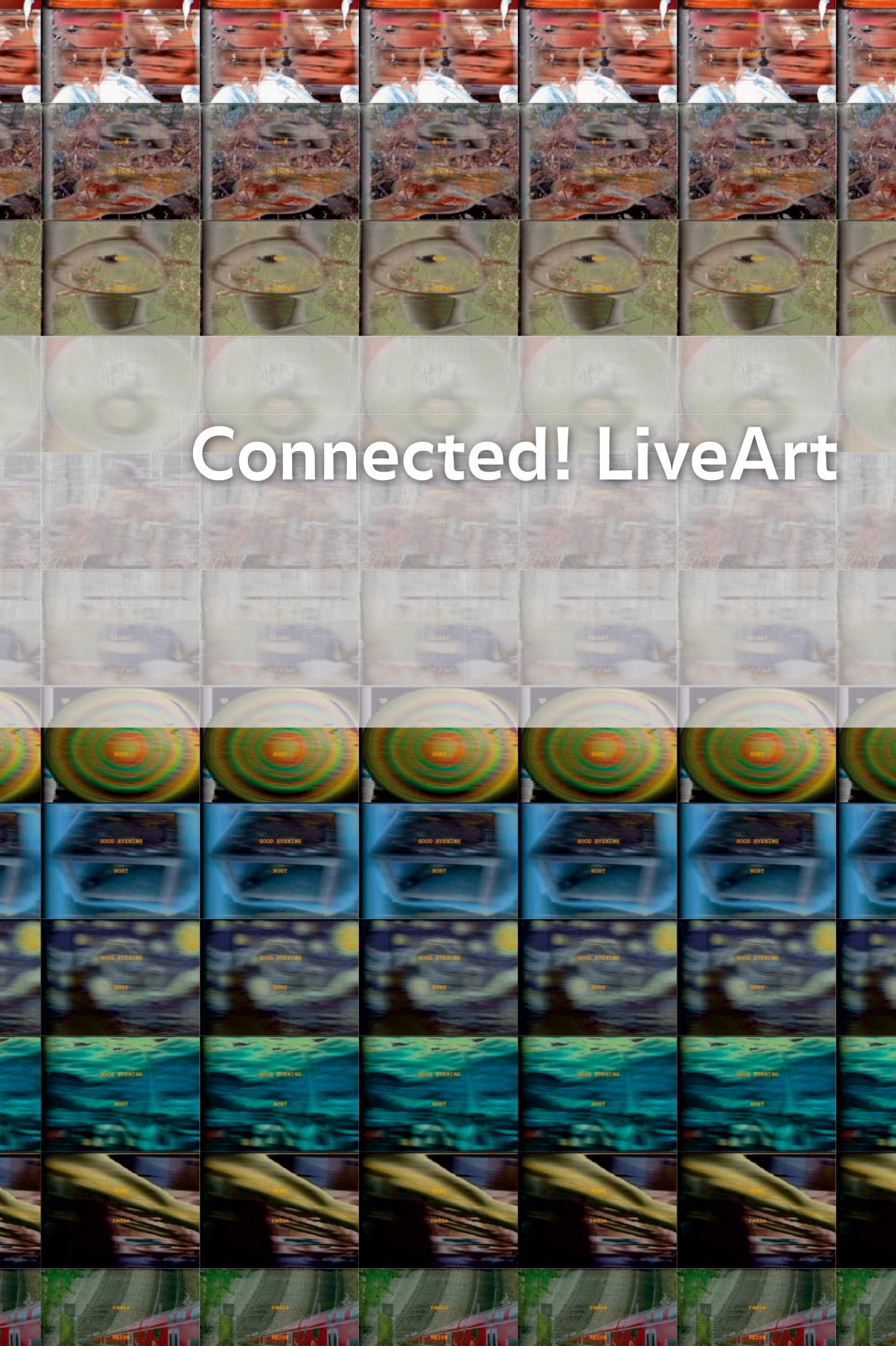Sher Doruff, Nancy Mauro-Flude (eds.): Connected: LiveArt (2005)
Filed under catalogue | Tags: · art, collaboration, installation art, media art, network art, networks, radio art, sound art, streaming, telepresence

“The Connected! Programme spanned a two year period from January 2003 to January 2005. It officially concluded with a celebratory Birthday party for Art in the Theatrum Anatomicum of Waag Society, the local ‘home’-base of many Connected! projects. Although most of the people present at that event agreed with Federico Bonelli’s assessment “that art could have committed suicide in 1984″ – the research and the show goes on.
The Connected! Programme had four nested components: Projects, Artists-in-Residence, Sentient Creatures Lecture Series and Anatomic. This book documents many of the activities in these domains; the lectures, the events, the workshops, the performances, the installations, the discourse. Yet, it’s interesting to note that pulling together material for this publication was a bit like trying to capture the wind. Much of the work produced in this two-year period emphasized the real-time process of the making. Documentation of that often fragile, unstable and always already ephemeral process is sketchy at best and marginal to the actualization of the event itself. For many of these artists, documentation is a secondary concern, an afterthought. For others, documenting is an integral process indistinguishable from the event itself.
There are myriad photos in this catalogue of artists behind their laptops. Myriad photos that say little about the levels and layers of codified communication emitted from those unseen screens. These casual, unpretentious shots are images of social networks in progress – the translocal – a feedback loop of the local effecting the global affecting the local affecting the global. Not only does the artwork produced, or better transduced, scramble representational meaning but so too does the process of making. Performance practice that addresses the indeterminate dance-on-the-edge-of-chaos in compositional processes is a felt thing, an experience that doesn’t always translate well in laptop snapshots.”
Co-writers: Federico Bonelli, Beth Coleman, Josephine Dorado, Lucas Evers, Wander Eikelboom, Howard Goldkrand, Jan-Kees van Kampen, Arjen Keesmaat, Jeff Mann, Mark Meadows, Hellen Sky, Michelle Teran, Ananya Vajpeyi
Publisher Waag Society, Amsterdam, September 2005
Creative Commons BY-SA 2.0 Netherlands License
160 pages
PDF (updated on 2012-9-3)
Comment (0)Piotr Czerski: We, the Web Kids (2012) [PL/EN/ES/DE/FR/EE/CZ/SE/RS/MK/CN/IT/RU]
Filed under essay | Tags: · democracy, free speech, freedom, freedom of information, internet, networks, web

Originally published on 11 February 2012 in the Polish paper Dziennik Bałtycki under the title My, dzieci sieci.
Creative Commons License BY-SA 3.0 Unported
View online, alt [Polish]
View online [English]
View online, alt [Spanish]
View online [German]
View online [French]
View online [Estonian]
View online [Czech]
View online [Swedish]
View online [Serbian]
View online [Macedonian]
View online [Chinese]
View online [Italian]
View online [Russian]
Discussion:
BoingBoing.net
TheAtlantic.com
Reddit
Youtube
Falkvinge.net
Facebook
Kultura20.blog.Polityka.pl
Techdirt
Tytuł został zapożyczony z kultowego bloga mydziecysieci.
Comments (2)Shen, Yu, Buford, Akon (eds.): Handbook of Peer-to-Peer Networking (2010)
Filed under book | Tags: · anonymity, computing, filesharing, internet, mobile technology, networks, p2p, privacy, trust, trusted computing

The handbook offers elaborate discussions on fundamentals of peer-to-peer computing models, networks and applications, and provides a comprehensive study on recent advancements, crucial design choices, open problems, and possible solution strategies. It is written by a team of leading international researchers and professionals
Peer-to-peer networking, a disruptive technology for large scale distributed applications, has gained widespread attention due to the successes of peer-to-peer (P2P) content sharing, media streaming, and telephony applications. In addition, a large range of new applications are under development or being proposed. The underlying architectures share features including decentralization, end system resources, autonomy, virtualization, and self-organization. These features constitute the P2P paradigm. Trends in information and network technology such as increased performance and deployment of broadband networking, wireless networking, and mobile devices are synergistic with and reinforce the capabilities of this P2P paradigm.
The Handbook of Peer-to-Peer Networking is dedicated to discussions on P2P networks and their applications, thus providing an exhaustive view of the state-of-the-art of the P2P networking field. Written by leading international experts, the volume contains fifty chapters dedicated to the following topics:
• Introduction to Peer-to-Peer Networking
• Unstructured P2P Overlay Architectures
• Structured P2P Overlay Architectures
• Search and Query Processing
• Incentive Mechanisms
• Trust, Anonymity, and Privacy
• Broadcast and Multicast Services
• Multimedia Content Delivery
• Mobile P2P
• Fault Tolerance in P2P Networks
• Measurement and P2P Traffic Characteristics
• Advanced P2P Computing and Networking
This comprehensive volume serves as an essential reference for researchers and professionals, The book is also suitable for computer science and engineering students at the advanced undergraduate level or higher who are familiar with networking, network protocol concepts, and basic ideas about algorithms.
Edited by Xuemin Shen, Heather Yu, John Buford, Mursalin Akon
Publisher Springer New York Dordrecht Heidelberg London
ISBN 978-0-387-09750-3
1421 pages

